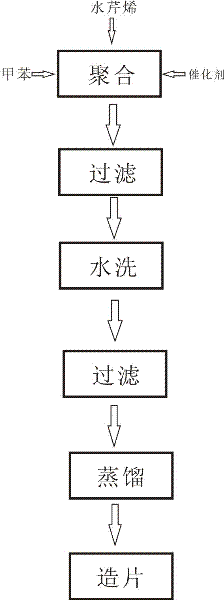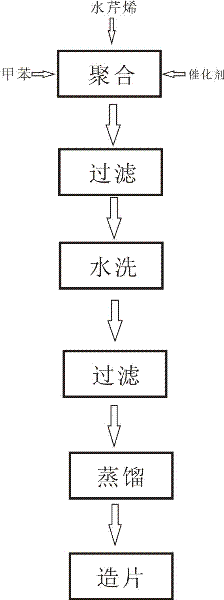Phellandrene resin production process
A production process, phellandrene technology, applied in coatings, adhesives, etc., can solve the problems of poor adhesive stability and high temperature resistance, low softening point of the product, high polarity, etc., and achieve good oxidation resistance and low cost. The effect of low and large molecular weight
- Summary
- Abstract
- Description
- Claims
- Application Information
AI Technical Summary
Problems solved by technology
Method used
Image
Examples
Embodiment Construction
[0012] Such as figure 1 Shown, the production technique of phellandrene resin, its operation comprises polymerization-washing-distillation-sheet making, in described polymerization process, toluene, catalyst are put into reactor, then put into phellandrene and carry out polymerization reaction, wherein , the weight ratio of phellandrene, toluene and catalyst is 100:150:4; the catalyst adopts Lewis acid iodine or iron. In the polymerization process, the temperature in the reactor is -10--0°C, and the polymerization reaction time is 8 hours.
[0013] Filtration processes are respectively added before and after the water washing process.
[0014] In the sheet-making process, the finished product is a solid transparent substance.
[0015] The performance contrast of the present invention and traditional product:
[0016] Phellandrene resin: color (iron-cobalt method) not greater than 2; softening point (ring and ball method) 135-150°C; acid value 0.5; saponification value not ...
PUM
 Login to View More
Login to View More Abstract
Description
Claims
Application Information
 Login to View More
Login to View More - R&D
- Intellectual Property
- Life Sciences
- Materials
- Tech Scout
- Unparalleled Data Quality
- Higher Quality Content
- 60% Fewer Hallucinations
Browse by: Latest US Patents, China's latest patents, Technical Efficacy Thesaurus, Application Domain, Technology Topic, Popular Technical Reports.
© 2025 PatSnap. All rights reserved.Legal|Privacy policy|Modern Slavery Act Transparency Statement|Sitemap|About US| Contact US: help@patsnap.com


